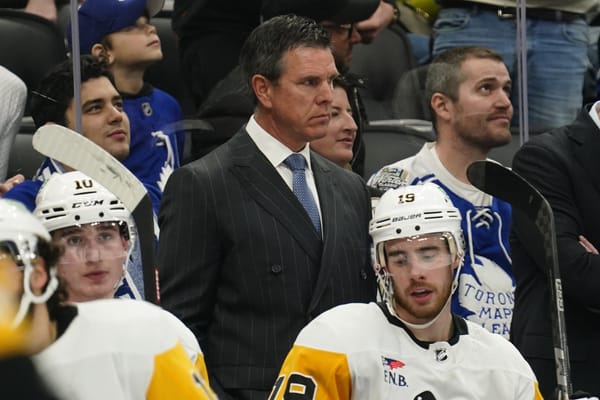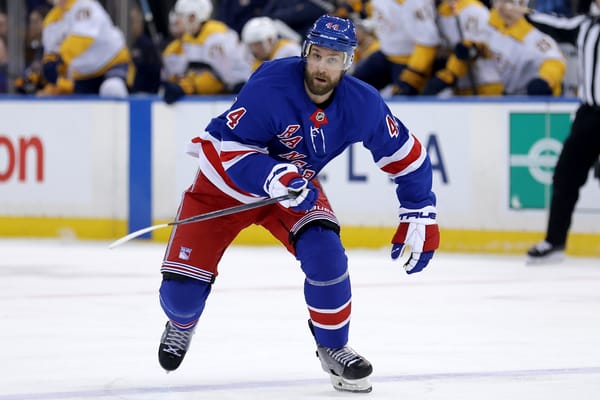Sprong, Puljujarvi Offer Trade Opportunities for the Rangers
The general blueprint of a rebuild should be to add as much young talent as possible, then worry about addressing needs later. Still, the two areas where the Rangers would benefit most from addressing are their lack of skilled wingers and their lack of right-handed forward shots.
On wing, the Rangers’ long-term options include Pavel Buchnevich, who is still trying to hit his stride, and 2018 first-round Vitali Kravtsov. Beyond those two, the Rangers lack players with realistic upside as bonafide top-six NHL wingers. As for right-handed shots, Mika Zibanejad is one, and a quality example at that. Outside of him, the organization is incredibly barren. Jesper Fast and Vinni Lettieri represent the NHL options, and only a handful of long-shot prospects (Ville Meskanen, Ty Ronning, etc.) exist at other levels. Our friend Steve Valiquette has for a long time pointed to righty TJ Oshie’s presence in the high slot as a critical element in the Capitals’ PP success, and while Jesper Fast is a phenomenal hockey player, it speaks to the Rangers’ weakness that he represents their best right-handed option in a similar role.
Those are not necessarily issues that the Rangers have to fix immediately; the rebuild is a multi-year process, and it’s best to wait for the right opportunities. As it happens, though, two potential trade partners have presented themselves in Edmonton and Pittsburgh.
The Pittsburgh Penguins have not started their season as they would have hoped. Through 16 games they have just seven wins and sit 19th in the NHL by points-per-game. Long-term, they are probably not in major danger of missing the playoffs. If they don’t nip this losing trend in the bud sooner rather than later, though, that could change.
The Penguins have had a particularly tough time integrating Daniel Sprong into the lineup. The skilled winger has just four points in 12 games. Displacing fellow right-wingers Phil Kessel and Patric Hornqvist is an unrealistic task for Sprong right now, and so the Penguins have often slotted the 21-year-old on the fourth line, though in fairness he did not show much in his auditions next to Sidney Crosby. The Penguins are trying to solve their problems without Sprong, but he would need to clear waivers in order to go to the AHL. Thus, he and the Penguins are in No-Man’s Land territory, and as he sits in the press box rampant rumors point to a trade manifesting sooner rather than later.
I got to watch Sprong often in the QMJHL, where he was a teammate of former Rangers’ prospect Ryan Graves. I also wrote about him for Sporting News last season when Pittsburgh was in a somewhat similar situation. Sprong is a dynamic forward with a wickedly deceptive wrist shot.
To again reference Valiquette’s work, the quickness of a release is often the difference between a goal and a save. As shown in the above clips, Sprong gets the puck off his stick with lightning speed, which gives goaltenders minimal time to track the puck and get set. The Rangers lack scorers overall, but even among those only Zibanejad can really threaten from beyond the goal mouth. Sprong has the ability to beat goaltenders from tougher spots.
Our own Evan Oppenheimer, newly added to the website’s staff, created a sophisticated statistic called “betweenness.” In essence, it measures how central a player is to a team’s offense by seeing both how much offense he (or she) creates as well as how much other players depend on him to create goals. Last year in the AHL, Sprong led the Baby Penguins in Betweenness, and in fact was among the league leaders in the stat. In other words, their offense revolved around Sprong. He was the catalyst.
This does not necessarily guarantee that it will translate to the NHL level, as he would be far from the first skilled player to dominate the AHL but lack the all-around game for the NHL (see Rob Schremp and Linus Omark, among others). But in theory, Sprong has the qualities that the Rangers lack within the organization.
Jesse Puljujarvi, drafted third fourth overall by the Edmonton Oilers in 2016, is another interesting trade target, though the circumstances are more nuanced. After registering just one point in 11 games, Puljujarvi was sent down to the AHL for the third-straight season on November 10th.
Despite the slow start to this season, there is plenty of upside to Puljujarvi. By the “eye test” he is pretty much everything scouts look for. At 6’4 and 200 pounds he has big size and a toolkit to make it worthwhile. His skating ability is sublime, and in particular he has strong straight-line speed. He can make creative plays with the puck. What’s more, he produces. His production in Finland as a 17-year-old was well beyond his years, and at the U18 World Championship he put himself in the same conversation as Jaromir Jagr. In his previous AHL stints, he put up high-end numbers for his age.
While Puljujarvi is probably not blameless for his slow start in the NHL, it’s hard to burden him with much responsibility given everything we know about the Oilers. This is a team whose game plan boils down to putting Connor McDavid and Leon Draisaitl on the ice as much as possible and hoping for the best. They have a long history of blowing it with young players and not much to speak of in terms of player development. Even still, Puljujarvi produced 12 goals in 60 games for Edmonton last season; not bad for a 19-year-old on a sinking ship. Absolutely nobody outside of the aforementioned twosome is doing much of anything for Edmonton right now, and so Puljujarvi was not exactly in a situation ripe for success.
There aren’t any inherent restrictions forcing the Oilers’ hand with Puljujarvi in the way that Pittsburgh is boxed in with Sprong. However, the many external pressures may lead to his availability. For his part, Puljujarvi doesn’t seem to be thrilled with his situation and, per TSN’s Bob McKenzie, any extended stint in the AHL might result in something resembling a trade request. General Manager Pete Chiarelli has tried to portray a strong lack of desire to trade him. That may be true. However, it may also be posturing for the sake of maintaining leverage.
It’s not exactly a stroke of genius to write an article pointing out that the Rangers should try to trade for good players. I’ve surely offered General Manager Jeff Gorton no help by drafting this piece. The hard part is actually having conversations with Pittsburgh and/or Edmonton and striking a deal.
The Penguins, perennial contenders (at least in theory), could be enticed by a number of players the Rangers have to offer. Mats Zuccarello makes the most sense for their needs. As strong as they are at right wing, they lack talent on the left. Pittsburgh would need to add another asset or two, but Sprong-for-Zuccarello is an obvious concept that could work. They could also be interested in Chris Kreider, Kevin Hayes, or Jesper Fast, though those deals would be harder to imagine.
There could also be a draft pick swap in play. The Rangers drafted four players in the top-40 last year, have Tampa Bay’s second (potential first) for this year, and will presumably add a few more draft picks at this season’s deadline. Pittsburgh’s prospect pool is empty and they have already traded their 2019 third-round pick and 2020 second. The Rangers could move from their surplus to acquire Sprong, while the Penguins could either keep the draft pick(s) to reinvest in a trade down the road or replenish their prospect pool.
Edmonton is a lot trickier to figure out for a number of reasons. First, this is a team that makes absurd trades out of habit. It’s impossible to set realistic limits for a trade with a team who previously moved Taylor Hall for a second-pairing defenseman, among many other questionable decisions.
One would have to think that Edmonton would only move Puljujarvi for a player who they think helps them immediately. They are in serious danger of inexplicably missing the playoffs for the third time in four years, and it’s hard to imagine Chiarelli surviving that kind of failure. Pretty much any roster player makes sense here. Zuccarello, Kreider, Hayes, etc. Jimmy Vesey seems like the kind of player Chiarelli loves. He also recently lamented his team’s lack of puck movers on defense. Neal Pionk sure can make plays from the back.
There’s no point in debating whether the Rangers should or should not trade for these players because the asking prices are unknown. However, it behooves the Rangers to make a serious inquiry into both. Both fit the mold of young, skilled, right-handed wingers who would fill a pretty sizable hole on the depth chart.




